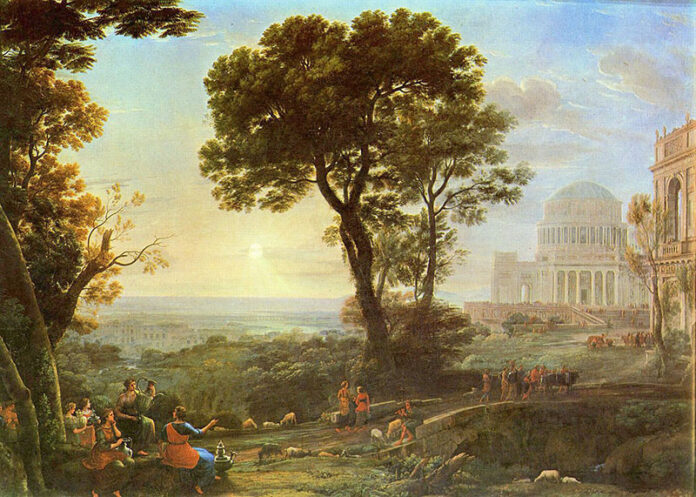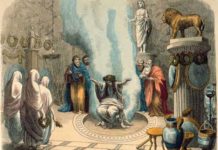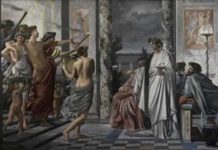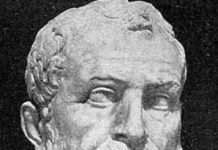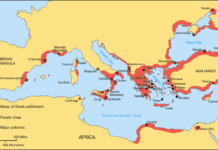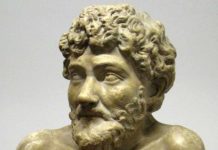Although the Delphic Oracle is best known for dispensing advice concerning imperial matters such as with Croesus, it became a repository of ancient knowledge and history.
High above the slopes of Mt. Parnassus, the Oracle of Delphi represented the epitome of ancient divination. Both the great and the lowly consulted the oracle for advice on personal matters to great questions impacting empires. Croesus acted on the oracles advice in 546 BC and lost an empire; Sparta and Athens received advice enabling them to defeat Xerxes in 481 BC. Even Nero visited the shrine, looting it of many treasures. Delphi was on the proverbial tourist route for many traveling Romans, including the Emperor Hadrian. Yet Delphi was much more than a place to seek answers for the future.
Delphi as a Repository of Ancient World Knowledge
Michael Grant writes that the custodians at Delphi, “amassed a unique corpus of information” regarding the ancient world. Sarah Pomeroy [1] comments, similarly, that, “The sanctuary became a storehouse of information about political conditions in the wide world.” Much of this resulted from the fact that the Delphic Oracle remained neutral in conflicts and represented a “Panhellenic” perspective amidst the collection of city-states often at war with each other.
Because the reputation of Delphi was so profound, the leaders of the ancient world viewed this particular oracle as the most reliable (Croesus consulted over 100 oracles scattered throughout the ancient world until he finally settled on Delphi, the only oracle to give a correct answer to his “test” question). Dedicated to Apollo, the oracle featured a priestess or “Pythia,” who allowed the god to speak through her after emerging from a lower room wherein she breathed the air that came from the sacred fissure.
Centuries of contact with so many cultures and city-states led to a vast amount of accumulated knowledge, perhaps enabling some of the answers given by the oracle, as well as so many treasures that Perrottet refers to the center as the “Fort Knox of antiquity.” City-states like Athens kept their treasuries at Delphi and the priestesses were often recipients of fabulous gifts.
Famous Prophetic Utterances Associated with the Oracle at Delphi
When Nero visited the shrine in 67 BC, he consulted the oracle about his future and was told to beware the seventy-third year. The young emperor felt that he would live for many more years. The number 73, however, referred to the age of Galba, who would replace Nero after a palace coup one year later. Edward Champlin refers to several stories involving Nero and the Oracle including the Priestess’ stinging remarks about his act of matricide as well as his personal identification with Orestes, the play by Euripides in which the protagonist kills his mother. Champlin states that none of these stories are verifiable. Suetonius mentions Nero’s visit to Athens (34) but does not mention Delphi.
When consulted by Athens and Sparta in the face of a renewed Persian invasion under Xerxes, the oracle at first predicted destruction. Being pressed for help, the oracle replied: “Then far-seeing Zeus grants this to the prayers of Athena; Safe shall the wooden wall continue for thee and thy children.” (Athena was the patron goddess of both Sparta and Athens) The Greeks took these words and built a navy of small, maneuverable ships to lure Xerxes fleet of 700-800 larger ships into battle at Salamis, defeating the Persians.
Ancient Romans Discounted the Delphi Oracle
The Roman world supplanted, in many ways, the ultimate need for an oracle to decide state policy. Hence, Delphi declined. Even when visited by Hadrian, the emperor’s question seemed far removed from the once heady inquiries upon which rested the fate of empires: Who were Homer’s parents? For an emperor as literate as Hadrian, the question probably made sense, yet he was not going to trust imperial decisions to what, by then, was viewed as a trivial magic show.
Sources:
C. M. Bowra, Classical Greece (Time Inc. Time-Life Books, 1965.
Edward Champlin, Nero (Belknap Press of Harvard University Press, 2003).
Michael Grant, The Ancient Mediterranean (History Book Club by arrangement with Plume, Penguin Putnam Inc. 2002).
Tony Perrottet, Route 66 A.D. On the Trail of Ancient Roman Tourists (Random House, 2002).
Sarah B. Pomeroy, Stanley M. Burstein, et al, Ancient Greece: A Political, Social, and Cultural History (Oxford University Press, 1999) [1] p. 127.


